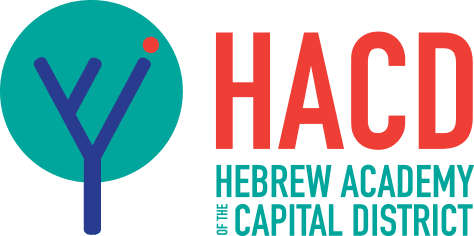Torah from HACD
Speaking with our Students: Parashat Ki Tisa, March 1, 2024
Our parasha is filled with interesting things. During my divrei Torah discussion with the students during Zman Kodesh on Monday, the students came up with all kinds of different ways to levy a tax which gave us a better sense of the purpose of the half-shekel tax. And in our discussion on Thursday, Odelia suggested that the problem with the sin of the Golden Calf was making an idol while Leo D. said that the problem was worshiping anything other than God–a subtle but significant distinction. Talking with, and more importantly, listening to our students provided me with my theme for this little bit of Torah from HACD.
In our parashah, Moshe receives the two tablets of the law. Unfortunately, the passage is often overshadowed by the fact that these tablets are broken by Moshe in response to the sin of the Golden Calf, and that Moshe had to carve a second set on his own. But the delivery of the two tablets is beautifully described by the Torah and amplified by the midrash.
|
When [the Lord] finished speaking to [Moshe] on Mount Sinai, God gave him the two tablets of the covenant law, the tablets of stone inscribed by the finger of God. |
וַיִּתֵּן אֶל מֹשֶׁה כְּכַלֹּתוֹ לְדַבֵּר אִתּוֹ בְּהַר סִינַי שְׁנֵי לֻחֹת הָעֵדֻת לֻחֹת אֶבֶן כְּתֻבִים בְּאֶצְבַּע אֱ-לֹהִים. |
The Torah describes that this is at the end of a forty day period (Exodus 24:18) in which Moshe neither ate nor drank (Deuteronomy 9:9).[1] No wonder, the Talmud in Menachot 29b describes Moshe as impatient as he watched God affix crowns to the letters of the Torah. Moshe exclaims, “Master of the Universe, what is delaying you?” I’ve always thought that Moshe must have been really hungry.[2]
A fascinating midrash, read from the perspective of my experience as a classroom teacher, gives me a different insight to Moshe’s impatience.
|
Exodus Rabbah 41:5 |
שמות רבה מ״א:ה׳ אָמַר רַבִּי שִׁמְעוֹן בֶּן לָקִישׁ מַהוּ לְדַבֵּר אִתּוֹ, מָשָׁל לְתַלְמִיד שֶׁלִּמְּדוֹ רַבּוֹ תּוֹרָה, עַד שֶׁלֹא לִמְּדוֹ הָיָה הָרַב אוֹמֵר וְהוּא עוֹנֶה אַחֲרָיו, מִשֶּׁלִּמֵּד אוֹתוֹ אוֹמֵר לוֹ רַבּוֹ בּוֹא וְנֹאמַר אֲנִי וְאַתָּה, כָּךְ כְּשֶׁעָלָה משֶׁה לַשָּׁמַיִם הִתְחִיל לוֹמַר אַחַר בּוֹרְאוֹ הַתּוֹרָה, כְּשֶׁלַּמְּדָהּ אָמַר בּוֹא וְנֹאמְרָהּ אֲנִי וְאַתָּה, הֱוֵי: לְדַבֵּר אִתּוֹ. |
This midrash builds on the ambiguity of the word אִתּוֹ ito, which can mean to him or with him. So when God finished [teaching Moshe the Torah], כְּכַלֹּתוֹ k’khalato, God spoke with him, alongside him.
The image of teaching here is a common one in Rabbinic literature: one teaches by speaking and one learns by listening and then repeating what one has learned. Only when one has mastered the content by learning to repeat it does one get to speak with the teacher. It is not clear from the text what is envisioned by “speaking with the teacher.” Does it mean that one can recite at the same time, kind of like how we frequently teach songs (including how I have been teaching songs on Tuesdays and Fridays during Zman Kodesh): first you listen and then you sing along with the teacher? Or does speaking with the teacher mean engaging the teacher in a real conversation that goes beyond the mastery of basic information?
I’m sure that after forty days of learning without eating or drinking, Moshe was probably quite ready to go down the mountain. But based on my own experience as a learner and as a teacher, if the learning were just repetition until I could correctly recite the text, I don’t think I could handle forty hours. Maybe not even 40 minutes.
I’m not critiquing God here. I’m questioning whether the rabbis who wrote this particular midrash have the same kind of educational sense that I have. If I wanted to keep Moshe up there on the mountain, eagerly learning the Torah, I don’t think it would be God speaking and Moshe repeating. Certainly a conversation would be better.
In a classroom (or in Zman Kodesh), I think the best form of learning is the exact opposite of the model in the midrash.
Instead of the classical
“Teaching is talking, learning is listening,”
I think it is more effective when
“Learning is talking and teaching is listening.”
Of course, God needed to put the text of the Torah in the center, but once the student understands how to center the text as the focus of the conversation, it is the student’s efforts to interpret, to make sense, to try out different kinds of meanings, to take risks (!) that demonstrate and effect real learning. When they take risks, listen to each other, and respond to the Torah and to each other, like we heard from Odelia and Leo, we hear Torah revealed in our midst.
Shabbat Shalom שַׁבַּת שָׁלוֹם (A peaceful Shabbat),
Jeff Spitzer (he/him)
School Administrator
[1] Tradition imagines that the Torah is given on the 6th of Sivan, although our date for Shavuot is never explicitly mentioned in the Torah. The forty days continue from the 7th of Sivan until the 16th of Tammuz. The next day, Moshe goes down from the mountain, sees the Golden Calf, and breaks the tablets, which we observe as a fast day, the 17th of Tammuz.
[2] Or more charitably, Moshe was eager to bring his learning to the people.
Shabbat Shalom,
Jeffrey Spitzer
